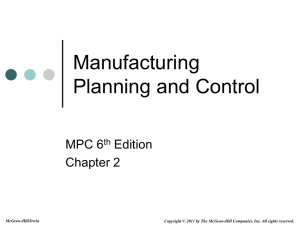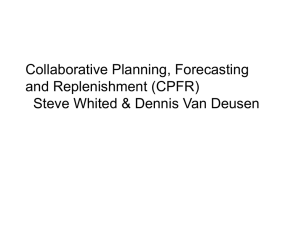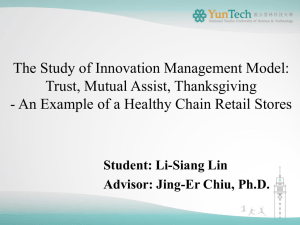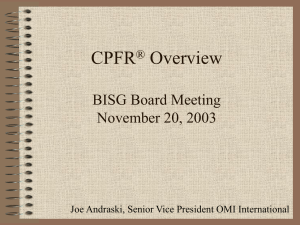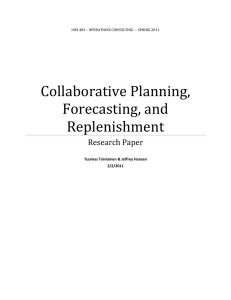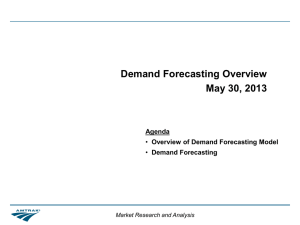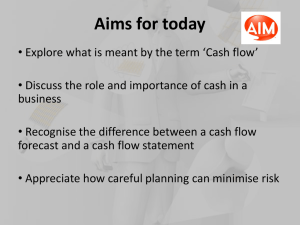0. The Context for MPC - Department of Computer and Information
advertisement
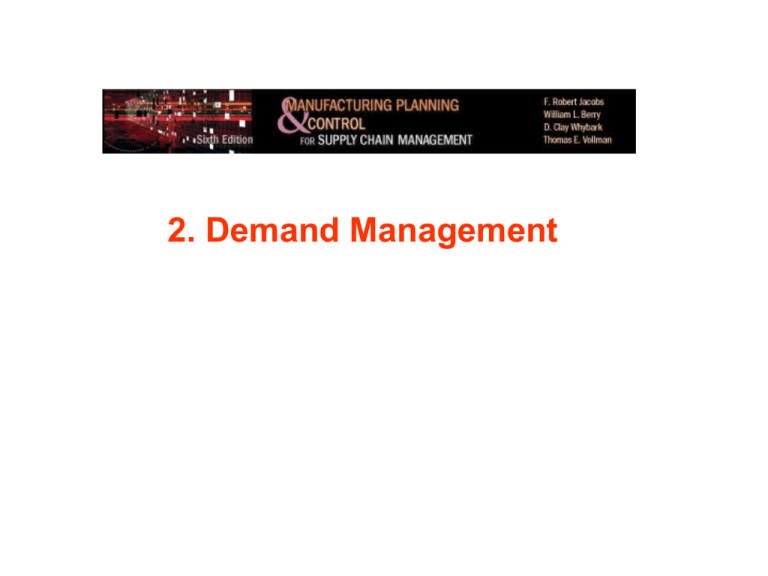
2. Demand Management 2.1. Demand Management in the MPC Demand Management is the key connection to the market in the front end of the MPC system. As such, we gather information from and about the market by engaging in forecasting customer demand, entering orders, and determining specific product requirements. It is through this module that quantities and timing for all sources of demands must be developed and coordinated with the planning (via SOP) and control (via MPS) activities of the company. 2.2. Demand Management & MPC Environments Classifying MPC environment in terms of “customer order decoupling point.” Customer order decoupling point is the point at which the firm, not the customer, becomes responsible for determining the timing and quantity of materials to be purchased, made, and finished. That is, the point at which demands changes from independent to dependent. 2.2. Demand Management & MPC Environments A. Make-to-Stock (MTS) Demand Management The key focus in this environment is on the maintenance of finished goods inventories. Considering the tradeoffs between inventory level and customer service level; defying the tradeoffs by being lean and flexible? Forecasts are needed for individual item level by location (e.g., plant warehouses, distribution center, local warehouses, and VMI) and time period. Concerns of increased forecast error at the item level? Use ratio/mix or % of aggregated forecasts as product mix is relative constant over time. 2.2. Demand Management & MPC Environments B. Assemble-to-Order (ATO) Demand Management ATO is made possible through built-in modularity in engineering design . The key task in this environment is to define customer orders in terms of available options, and to keep customer due date promise. Advantages of moving from MTS to ATO: improved product flexibility, forecast, and reduced inventory carrying costs (e.g., Dell PC; xn vs. nx). Component inventory affects customer service. 2.2. Demand Management & MPC Environments C. Make-to-Order (MTO) Demand Management The primary task in this environment is to get product specifications from the customers and translate these into manufacturing terms in the company (e.g., QFD). Two key factors are design (specification) and lead time (components) since they can affect the resource availability (e.g., components and engineering) of other products. Adjusting capacity after orders are released to the shop floor. 2.3. Communication with Others Demand Management <=> SOP Demand management needs to provide SOP with all sources of demand forecast information (spare parts, promotion, inventory buildups or backlog, etc.) both in timing and quantity (e.g., green Volvo). Demand Management <=> MPS The underlying concept is that forecasts are consumed over time by actual customer demands/orders, in terms of planned materials and capacities. Thus, as customer orders are received and entered into the MPS, the detailed order information must be provided to the master production scheduler. Likewise, the status of orders, capacity consumed (and available) must be provided to demand management to keep customers informed. MPS example. Demand Management <=> Customers Order booking/service/entry: communication from the customer (order and change requests) and to the customer (delivery date and order status). A process of consuming the forecast with actual orders. 2.4. Information Use in Demand Management • EDI (electronic data interchanges, since 1970s) – A technology that enables the transmission of routine business documents having a standard format from computer-to-computer, phone or dedicated lines. The software is complex (X12 Form has 150 fields) and expensive using batch processing (orders, invoices, payments, etc.) • E-Commerce (Internet-based systems) – flexible (Java applets) for any communication (ftp, http, email, etc), low cost, near real-time, reaches wider community of users. 2.4. Information Use in Demand Management Supply Chain Management (SCM) represents one of the most significant paradigm shifts of modern business management by recognizing that individual businesses no longer compete as solely autonomous entities, but rather as supply chains. Make-to-Knowledge (replacing forecasts with knowledge) The notion that allows supply chain members (between a pair of supplier and customer) to operate with knowledge of the other firm’s needs/operations to enhance the competitiveness of the entire chain, not just that of each of the companies independently. Fig. 2.6 2.4. Information Use in Demand Management Data Capture and Monitoring For SOP: capturing the overall market trends and patterns for the product families. For MPS: monitoring the detailed product mix. CRM (customer relationship management) technologies link front office (e.g., sales, marketing, and customer service) and back office (e.g., operations, logistics, and human resources) functions with the company’s customer “touch points” including the Internet, email, sales, call centers, stores, etc. Data from CRM, reflecting more closely actual customer demand, can be used to develop make-to-knowledge plan. Reading: “Understanding CRM…” by Chen and Popovich in BPMJ 2.5. Managing Demand Demand Management is the gateway between the firm and marketplace, where: market intelligence is gathered forecasts of demand are developed status of customer orders is maintained Demand Management responsibility is fulfilled by various functional departments. For example, when an order is received, credit check ↔ order entry ↔ materials/parts ↔ delivery ↔ logistics dept. 2.5. Managing Demand credit check ↔ finance/accounting dept. order entry ↔ sales (customer service) dept. materials/parts ↔ purchasing (supply management) dept. delivery ↔ logistics dept. The coordination can be done by sales and marketing or supply chain management dept. or materials management dept. Responsibility of coordination must be well defined ! Authority for order changes (see figure) 2.5. Managing Demand Service level setting: service level = 1- stock-out risk Inventory investment increases exponentially as service level is increased! Demand Filter Monitoring: checking demand against a range of reasonable values (e.g., 4 MADs). When an “unusual” demand is found, it could be treated separately so that it won’t influence the average (forecast). e.g., 10, 9, 11, 32, 12, 14, 13 Demand Management capability (see DELL’s DNA) 2.5’. Dell’s Supply Chain DNA Dell’s Four Core Capabilities SCM Capabilities Demand Management Processes Direct model (A-T-O) People Maniacal about execution/ Bias for action Business fundamentals Balance sheet/ P&L Rewarded for decreasing costs 2.6. CPFR Collaborative Forecasting, Planning, and Replenishment (CFPR) Recall uncertainty and the Bullwhip effects. CFPR is a supply chain initiative designed to improve competitiveness by focusing on communication and information sharing among supply chain trading partners in planning, forecasting, and inventory 2.6. CPFR Collaborative Forecasting, Planning, and Replenishment (CFPR) Goal: reducing variance between supply and demand Eliminates typical order processing. Forecasts can be frozen and then converted into a shipping plan. Developed by the Voluntary Interindustry Commerce Standards Association (VICS) 2.6. CPFR Background: Wal-Mart has long been known for its careful analysis of cash register receipts and for working with suppliers to reduce inventories. In the past, like most other retailers, Wal-Mart did not share its forecasts with its suppliers. Retailers ordered more than they needed in order to avoid product shortages and lost sales, and suppliers produced more than they could sell. 2.6. CPFR Background: Benchmarking Partners, Inc. was funded by Wal-Mart, IBM, SAP, and Manugistics to develop a software package called CFAR (pronounced “see far”), which stands for collaborative forecasting and replenishment. Wal-Mart initiated CFAR with Warner-Lambert’s Listerine product. 2.6. CPFR Background: The parties went through as many cycles as needed to converge on an acceptable forecast. Wal-Mart benefits: 1. in-stock position from 85% to 98%, 2. increases in sales and reduction in inventory costs. Warner-Lambert benefits: 1. smoother production plan, 2. lower average costs. 2.6. CPFR: Other Results • Nabisco and Wegmans 50% increase in category sales • Wal-Mart and Sara Lee 14% reduction in store-level inventory 32% increase in sales • Kimberly-Clark and Kmart Increased category sales that exceeded market growth 2.6. CPFR: Other Results • Sears and Michelin 25% combined inventory reduction • Campbell Soup reduced the inventories of retailers from 4 to 2 weeks’ supply = savings of 1% of retail sales. 9-Step CPFR (Fig. 2.7) 1 2 3 4 5 • Establish collaborative relationship – may require culture change & process redesign • Create joint business plan • Create sales forecast • Identify exceptions to the sales forecast • Resolve/collaborate on exception items 9-Step CPFR (Fig. 2.7) 6 7 8 9 • Create order forecast • Identify exceptions to order forecast • Resolve/collaborate on exception items • Generate order 2.6. CPFR • Culture change from traditional transactional relationships between buyers and suppliers to collaborative relationships. • CPFR is grounded on the paradigm of strategic management theory that emphasizes the development of collaborative advantage, as opposed to competitive advantage. Within the collaborative paradigm, the business world is composed of a network of interdependent relationships developed and fostered with the goal of deriving greater and mutual benefits (JOM, Chen and Paulraj 2004). Buyer-Supplier Relations Competitive (arm’s length) Orientation: Zero-sum game between supplier and buyer When a buyer has more clout? • Big share of suppliers’ sales Buyer-Supplier Relations Cooperative/Collaborative Orientation: Seller and buyers are partners Becomes popular with dramatic JIT success Supplier as a Partner Aspect Competitive Cooperative Number of suppliers Many One or a few Length of relationship May be brief Long-term Low price Major consideration Moderately important Reliability May not be high High Openness Low High Quality May be unreliable; buyer inspects At the source; vendor certified Volume of business May be low High Flexibility Relatively low Relatively high Location Widely dispersed Nearness is important 2.6. CPFR Adoption • Despite promising pilots, CPFR’s adoption rate has been slower than expected. companies may still have legacy information systems that delay implementation. Information sharing requires that partners trust that they are working in each other’s best interests. A good Research paper topic. (current state, success factors, implementation barriers, etc.)
